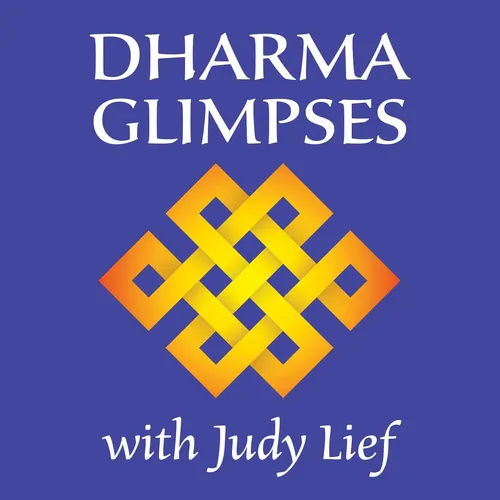
Dharma Glimpses with Judy Lief
DHARMA GLIMPSES is an introduction to The Profound Treasury teachings of Chögyam Trungpa Rinpoche, taught by Judy Lief. In these short, accessible talks, Judy invites listeners to explore the subtleties and delights of the Buddhist path of meditation and insight. She introduces listeners to some of the key ways that mark Chögyam Trungpa Rinpoche's unique and brilliant exposition of the dharma in the context of contemporary Western society.
- Update frequency
- every 7 days
- Average duration
- 7 minutes
- Episodes
- 241
- Years Active
- 2020 - 2025

Episode 61: Teachers and Students
The idea of teacher on the simplest level is the need to connect with people who know more than we do about something • in some ways a teacher in the contemplative world is more like a coach than a…

Episode 60: Portals to the Sacred
Can you think of moments in your life when you’ve had a glimpse of something that might feel profound beyond words, and maybe slightly disturbing? • in those moments when we are stopped in our trac…

Episode 59: The Challenge of Aspirations
Aspirations like the Four Limitless Ones are based on the recognition that our actions stem from simple thoughts in our mind; so why not put benevolent thoughts in our mind and see what comes of it? …

Episode 58: Positive Seeds
What are aspirations? are they just thoughts? and if so, what benefit could they possibly have? • we have lots of empty thoughts, dreaminess, and ideas; even in one session of sitting practice all …

Episode 57: Four Limitless Aspirations
The context for talking about happiness in the Buddhist tradition comes from an aspiration that has four parts: • may all beings enjoy happiness and the root of happiness • may they be free from…

Episode 56: The Happiness Enigma
Happiness seems to be something we all want but don’t often get; and when we do get it, it doesn’t seem to last • the search for happiness can seem like a receding horizon: we keep trying to get th…

Episode 55: Loving Kindness and the Root of Happiness
Buddhist training is not just about clarifying and taming the mind; it is also about cultivating the heart • loving kindness is the wish that all beings enjoy happiness and the desire to remove the…

Episode 54: Good Dharmic Bread
My own teacher liked to use the analogy of making bread when talking about living traditions versus traditions that have become dead or static • watching a great master making bread could be so ins…

Episode 53: Critical Thinking
A general assumption or bias about meditation is that it’s all about calming down, taming the mind, and getting more chill • but in fact meditation has two components: one is a sense of calming, se…

Episode 52: Hideouts and Extreme Views
In the buddhist tradition, “eternalism” and “nihilism” are known as the two extreme views • they describe two different ways of hiding out, of removing ourselves from the rawness and intensity of i…

Episode 51: The Three Jewels
In the buddhist tradition, the three jewels represent the three supports for one’s spiritual journey: the buddha, the dharma, and the sangha • they are called jewels because they are colorful, mult…

Episode 50: A Simple Daily Practice
The practice of stopping and reflecting has to do with paying attention to the beginnings and endings of things • when you first wake up, taking just a minute or two to regroup yourself: what are y…

Episode 49: Fresh Start
We never know day to day what we will have to face; some days are smooth, but other days we feel completely overwhelmed • but there is always a chance to start fresh, to disrupt the painful pattern…

Episode 48: Refraining from Harm
In buddhism the principle of refraining from harm is not about heavy-handed moralism • it’s based on mindfulness and awareness: noticing what causes us to feel good and what causes us to feel bad, …

Episode 47: Four Supports for Right Action
Post-meditation practice focuses on how we mix the dharma with the challenges of everyday life • the four supports for right action provide guidelines for acting in a way that is skillful, that doe…

Episode 46: Noticing and Questioning
So much of what happens on the Buddhist path depends on what we notice and what we question • the Buddha’s path to enlightenment began with noticing and questioning—noticing the stages and the chal…

Episode 45: An Unfolding Path, continued
The idea of being on a path is a deeply positive one: instead of just trying to get through the day, the ups and downs of life become a pathway • it is also a challenging one: yes there are guideli…

Episode 44: An Unfolding Path
Buddhism is referred to as a path or a journey because it’s not just a tradition we belong to, it’s something we do—it’s a personal path that we create as we walk along it • like any path, there is…

Episode 43: Three Gates of Liberation
In the buddhist teachings, body, speech, and mind are referred to as the three gates of liberation • these three gates are connecting points, or portals, between you and the teachings of the Buddha…

Episode 42: Three Bowls, continued
In the previous episode we looked at the analogy of the three bowls (the upside down bowl, the cracked bowl, and the bowl laced with poison), and contrasted them with the ideal bowl as an example of …